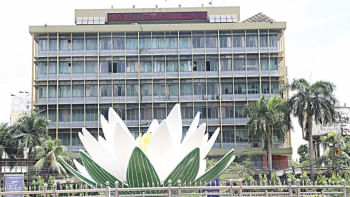Can mergers heal banking sector’s wounds?

The news that Shariah-based Exim Bank is going to merge with troubled commercial lender Padma Bank has taken the financial sector of Bangladesh by surprise.
Mergers and acquisitions are widely used practice in the global financial sector. Although it is not entirely new in Bangladesh, the instances are few and far between.
The merger comes as the central bank got down to bringing in much-needed governance to the financial sector, especially the banking industry, where irregularities are rife.
Approving loans under pressure from influential quarters, political influence, taking loans through fake names and companies, and influence on management by directors are some of the examples of excesses that have taken a toll on the banking system, all combining to send the non-performing loans (NPLs) to an unsustainable level.
As of December, the banking sector's defaulted loans stood at Tk 1,45,633 crore, which accounted for 9 percent of the credits disbursed, central bank data showed. However, the distressed assets, which are calculated considering the NPLs, outstanding rescheduled and write-off loans, amounted to Tk 3,77,922 crore as of 2022.
Of the 61 banks in Bangladesh, 10 to 20 banks have become weak due to the lack of governance and massive loan irregularities, hitting the confidence level of depositors.
After a meeting with the BB governor recently, Nazrul Islam Mazumder, chairman of the Bangladesh Bank Association, a platform of owners of banks, told reporters that around 90 percent of banks in the country are in good shape and the rest 10 percent are weak.
In order to address the governance issue, the central bank in February unveiled its roadmap. As part of the strategy, as many as 10 weak banks could be absorbed into sound banks, and Padma Bank's merger is the first of the process.
Bringing governance through mergers is not an easy task and the success sometimes depends on which banks will be merged with what kind of lenders.
In 2009, Bangladesh Shilpa Bank and Bangladesh Shilpa Rin Sangstha merged to form Bangladesh Development Bank Ltd (BDBL). The new entity is still creaking under the weight of bad loans.
The NPLs of BDBL stood at Tk 982 crore in December, which made up 42.46 percent of the disbursed loans.
There have been successful examples as well.
For instance, Standard Chartered Bank and ANZ Grindlays Bank merged to form StanChart Grindlays in 2000. It was later named Standard Chartered Bangladesh. Today, the multinational lender is the most profitable venture in Bangladesh.
In 2001, Bank Asia acquired the business operations of the Bank of Nova Scotia in Dhaka, the first of its kind in the banking history of Bangladesh. The bank also took over the country operations of Muslim Commercial Bank Ltd. Today, Bank Asia is one of the successful banks in the country.
Analysts say the merger of a weak bank with a relatively stronger one will set a bad precedence and encourage others to commit loan irregularities and finally avail bailout from the government.
In a recent central bank report on banks' health, Padma Bank was in the red zone and Exim Bank was in the yellow zone. This means both banks are weak.
When two weak banks merge, it will be difficult to form a good bank as seen in the case of BDBL.
In the merger of Padma Bank and EXIM Bank, the bad loans of the problematic bank will be bought by an asset management company of the government, according to central bank officials. But if that happens, it will be a bailout package from the government for the ailing bank.
Already Padma Bank has received regulatory forbearance from the central bank and the government. State-owned Investment Corporation of Bangladesh, Sonali Bank, Janata Bank, Agrani Bank and Rupali Bank bought a 60 percent stake in the bank for Tk 715 crore. But it has failed to stand on its own.
Zahid Hussain, a former lead economist of the World Bank's Dhaka office, said a comprehensive audit is essential before mergers and acquisitions.
If the audit finds out Exim Bank's health to be weak, it will not be wise to merge Padma Bank with it because the move will not yield the expected outcome, he said.
The economist said some banks want to come under mergers and acquisitions due to regulatory incentives or forbearance but this is contradictory to the aim of the initiative as it looks to restore good governance.
Anis A Khan, a former managing director of Mutual Trust Bank, echoed Hussain.
"It will be hard to bring good governance through mergers because dispute may emerge in the new entity."

 For all latest news, follow The Daily Star's Google News channel.
For all latest news, follow The Daily Star's Google News channel. 











Comments